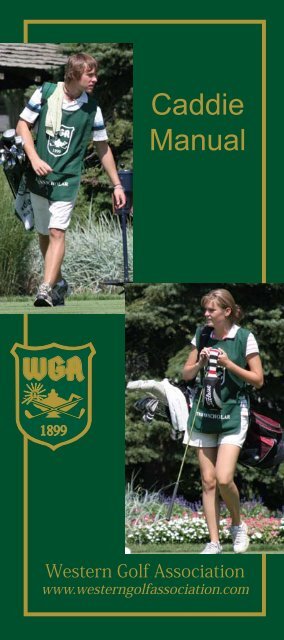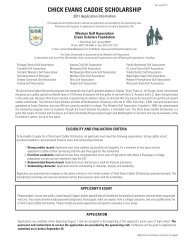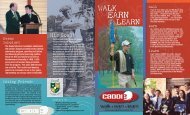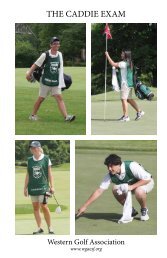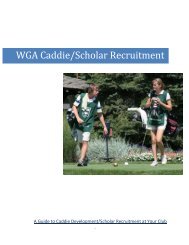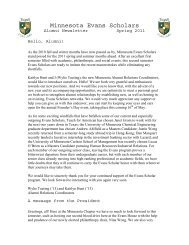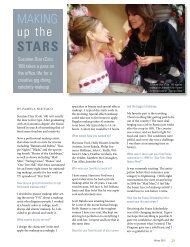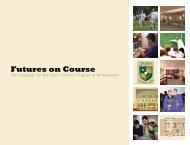Caddie Manual - Western Golf Association
Caddie Manual - Western Golf Association
Caddie Manual - Western Golf Association
Create successful ePaper yourself
Turn your PDF publications into a flip-book with our unique Google optimized e-Paper software.
<strong>Caddie</strong><strong>Manual</strong><strong>Western</strong> <strong>Golf</strong> <strong>Association</strong>www.westerngolfassociation.com
The Evans Scholars ProgramSending <strong>Caddie</strong>s to College Since 1930The <strong>Western</strong> <strong>Golf</strong> <strong>Association</strong> is a national organization ofmember clubs. It was founded in 1899 with the purpose ofconducting national championships and providing generalservice to the game of golf.In 1930, the WGA became the sponsor of the Evans ScholarsProgram, which was established by and named for Chicagogolf great Charles “Chick” Evans Jr., who chose to remain anamateur. He won 54 tournaments over a competitive career thatspanned four decadesChick wanted to give something back to the game of golf, andhis dream became a reality in 1930 when the first two caddiesattended Northwestern University.Today, the Evans Scholars Foundation administers the nation’slargest privately funded college scholarship program. Since1930, nearly 8,600 young men and women have graduated fromthe Evans Scholars Program. Each grant consists of full tuitionand housing (where applicable) and is renewable for up to fouryears. The Foundation owns and maintains Evans ScholarshipHouses at 14 universities.To apply for an Evans Scholarship, you must fulfill four requirements:1) strong caddie record; 2) excellent academics; 3)demonstrated financial need; 4) outstanding character.<strong>Caddie</strong>s may obtain information and an application from their<strong>Caddie</strong> Superintendent.1
INTRODUCTIONWhat is caddying? Carrying someone’s clubs and assistingthem around the course is an important part of the gameof golf and a rewarding job. The money is excellent, youdevelop interpersonal skills, and work outdoors. Caddyinggives you an opportunity to meet successful andinfluential people and to potentially qualify for a collegescholarship.Caddying is part of golf’s heritage, “the way golf was meantto be played,” and part of its future. It is also a great wayto learn the game of golf. Caddying is an investment forthe future of golf and also an investment for the future ofyoung men and women.Thoroughly read and study this manual. Ask your <strong>Caddie</strong>Superintendent or <strong>Golf</strong> Professional to explain anythingthat is confusing. The better you know this manual, thebetter caddie you will become.This book is published by the <strong>Western</strong> <strong>Golf</strong> <strong>Association</strong>.<strong>Caddie</strong>s are an important part of the game of golf. TheWGA is working to keep young people like yourselvesactive and interested in this great sport.Please contact the <strong>Western</strong> <strong>Golf</strong> <strong>Association</strong> at (847)724-4600 with further questions.3
THE CADDIE SUPERINTENDENT<strong>Caddie</strong> Superintendents are given the task of recruiting,training, nurturing and supervising a golf club’s caddies.They must also communicate effectively with the golfprofessional and other golf club staff members and canhave a significant influence on the extent to which themembership enjoys the game at their club.A professionally trained, knowledgeable, and courteousgroup of caddies and a well managed caddie programcan help a golf club deal more effectively with slow play,significantly add to the number of enjoyable rounds ofgolf, and enhance the golf club’s overall image of a wellmanaged, first-class operation.Each club will have its own set of rules and procedures forcaddies to follow, so be sure to learn them quickly. Do notbe afraid to ask your <strong>Caddie</strong> Superintendent questions,not only about your service to the players, but also:•How, when, and where to report to work andawait an assignment.•How, when, and where to go and what to do whengiven an assignment.•How, when, and where you will be compensated foryour work.•How, when, and where to obtain information on collegescholarships.4
THE BASIC JOB OF CADDYINGThe caddie has been a part of the game of golf almostfrom the beginning. The Rules of <strong>Golf</strong> define the specificrole of the caddie, but your primary purpose as a caddieis to assist the player you are working for. Basic dutiesinclude: carrying the bag, pacing yardages, replacingdivots, raking bunkers and attending the flagstick. Whena player enjoys a round of golf, so will you. You and theplayer are a team on the course and your work is a fundamentalpart of a successful round.By following the procedures and suggestions in thismanual, your work will be easier. Always listen to yourplayer and older caddies when they give you advice;they have the experience that could help you become agood caddie.A CADDIE’S TOOLSEvery job has tools, and caddying is no different. Thereare at least four essential tools a caddie needs in orderto perform his/her duties properly.•First, you need a towel to keep the clubs clean anddry. A 20" x 40" white towel is ideal. Never use atowel from the club, unless it is provided. Manyclubs require the caddie to bring a towel from home.It is important to keep at least a quarter of the toweldamp (wet on really warm days) in order to clean thegolf ball and groves of the club and caked-on mudor grass.•Second, you should carry a ball mark repair tool tofix impact marks that balls make when landing onthe green. Watch your player fix ball marks a coupleof times before you start fixing them. Only do this iftime allows.•Third, a good caddie always has an extra pencil anda few tees in his/her pocket in case the player needsthem during the round.•Fourth, a caddie needs a good comfortable pair ofshoes. Never wear golf spikes or ripple soled shoesthat can damage the greens. Tennis shoes are fine,but your choice of shoes should look presentable, giveyour feet support, and keep them dry.•Fifth, weather permitting, most clubs require a caddieto wear a club shirt and maybe a hat. You may have topurchase these items from the club. Proper rain gearshould be considered when necessary.5
Be ready to takeyour player’s club,but only if he/shehands it to you.Never grab or askfor the club.7
ON THE TEE1. Take note of the brand and type of golf ball your playeris using for the round.2. You should line up on the right-hand side of the teeingarea. Bring the bag right up to the tee marker. Theshortest caddie should be in front and the tallest inback, ensuring proper vision for each caddie.3. Be careful of your shadow, so that it does not fall onthe teeing area, distracting the player. Back away ifyour shadow does or if you are too close to the playerteeing off.4. Stay quiet on the tee when a player is hitting. Keepa careful watch on your player’s drive and mentallymark it with something in the fairway or rough (usuallya tree or a mound). If the sun is in your eyes, use yourhand or a visor of some type to block the rays whilecontinuing to follow the flight of the ball.5. Help your fellow caddies by watching the flight of allthe players’ balls. A good caddie knows the positionof each player’s ball.6. Be ready to move off the teeing area quickly after thelast player hits. When your player hands you the club,clean it and place it back in the bag. Be prepared toclean and dry the club while walking towards yourplayer's golf ball. Replace the head cover if the clubhad one. Never misplace a head cover. Proceed offthe tee and stay ahead or even with your golfer asyou walk to the ball. SUGGESTION: The teeing areais usually a good spot to reorder the clubs if they wererearranged on the last hole. Be sure to keep quietwhile doing so.8
THROUGH THE FAIRWAY1. Walk ahead or alongside of the player; do not lag behind.Walk with your hand over the clubs or a towel wovenbetween the clubs so they do not rattle. Be attentiveof where you are walking and where the group’s golfballs are.2. When proceeding off the tee, move quickly to yourplayer’s ball but do not go beyond the farthest ball fromthe green. If it is not your player’s ball, stand away fromthe player hitting.3. As you approach your ball, find the closest yardagemarker and walk off the yardage to the hole. You willeither be adding or subtracting yardages dependingupon the location of the yardage marker in relationto the ball. Yardage markers are to the center of thegreen. Inform your player of the yardage. This shouldbe the only time you volunteer information. As you gainmore experience, you might also want to inform yourplayer about the wind direction and flagstick location.4. When arriving at the ball, check to see if it is yourplayer’s. If you cannot identify it as your player’s, DONOT TOUCH IT. Let the player identify it. Bring thebag up directly to the ball and stand to the right of theball (left if caddying for a left-handed player) and onepace back. Place the bag on the ground with the clubsface up and wait for the player to select a club. Onceyour player has chosen a club, step away a couple ofpaces. Carefully watch the flight of your player’s balland note its position. CAUTION: If your player is playingthrough trees, stand where you will not be hit bythe ball but can still watch its flight.5. After your player has hit and if a divot was made, replacethe divot quickly. Run to the divot and replace it in itsoriginal position. Place it in the hole with the roots facingdown. Step down on the divot twice to make sure itis replaced properly. When your player hands you theclub, clean it thoroughly. Place the club in the properorder in the bag. SUGGESTIONS: You can clean theclub while you are walking to the next shot. Hand yourplayer the putter if the shot landed on the green. A playershould never have to ask for his/her putter.9
AROUND THE PUTTING GREENThe putting green is probably the most important areaon the course. You should be especially careful whenperforming your duties here.1. Hand your player the putter as soon as the ball is onthe putting green.2. If your player is first to land on the green, it is yourresponsibility to attend to the flagstick. Place your bagdown on the ground nearest to the next teeing areaand bring your towel with you back to your player. Offerto wash the golf ball and then proceed to the flagstick.WARNING: Never lay your bag down on the fringe orputting green. Also, never run or jump on the puttinggreen.3. If you are not attending the flagstick, stand off theputting green in an area that is not in anyone’s line ofputt. The line of putt is an imaginary line that extendsfrom the player’s ball through the hole. Keep quiet.Never stand behind the hole or the player when he/she is putting.4. If time permits and you know how, fix any ball marksyou see on the green. Be sure not to distract anyonewhile they are putting.Attending the Flagstick1. Learn to judge which ball is furthest from the hole. Thisplayer putts first.2. When walking on the putting green, be careful not tostep in anyone’s line of putt. The line of putt extendsfrom the ball to the hole. Be aware of the positions ofall the balls.3. When you get to the flagstick, make sure it is not stuckin the hole by twisting it. Ask the furthest-away playerif they would like the flagstick out or attended.“Sir/Ma’am, would you like the flagstick attended?”4. If the player does not want you to attend the flagstick,remove it carefully and move to the edge of thegreen away from the line of putt.10
5. If the player wants you to attend the flagstick, standso your feet are at least two feet from the hole andyour shadow does not cross the player’s line of putt.If you can reach the flag atop the stick, hold it so theflag does not blow in the wind. Make sure your feetare together and pointing towards the player for whomyou are attending the flagstick. WARNING: Be sure notto step or stand on or near the hole, which can causedamage to the hole.6. Once the player strikes the ball, remove the flagstickcarefully from the hole. Move to a side of the puttinggreen, being careful not to step in anyone’s line of putt.Keep Quiet. You may have to attend the flagstick formore than one player so be prepared. If you are notsure, just ask.7. After all the players have holed out, return the flagstickto the hole. Be careful not to hit the edge of the hole withthe bottom of the flagstick. This causes damage to theedge of the hole. Quickly move off the green and meetyour player at the next teeing ground. Once you get toknow the course and your player, you should have his/her driver ready to exchange for the putter.Finishing The Round1. Thank your player. “Thank you Mr. Smith, it has beena pleasure caddying for you today.”2. This is when your player will compensate you for yourwork and evaluate your performance on a ticket that youare handed when you begin the round. Stand away fromyour player while they do this. NEVER look over yourplayer's shoulder while he/she is signing your card.3. Ask your player where they would like the bag to beplaced and return it there promptly. A member’s bagis usually returned to the bag room. If you are caddyingfor a player’s guest, ask where they would like thebag to be placed.4. Make sure you count all the clubs and that they areclean before leaving the bag.5. Return to the caddie room and either await a second assignmentor check out according to your club’s rules.11
Hand your player the putter as soon as his/her ball has reached thegreen.Player No. 2 is away and will need the flagstick attended. The arrowswill show that you can take two paths to the flagstick. Your shadow maybe over the hole, so you may have to stand on the other side.X<strong>Caddie</strong>>
BUNKERSWhen your player’s ball lands in a bunker there are specialduties that need to be performed.1. Stand outside the bunker as your player is makingthe shot.2. After your player has completed the shot, take theclub and lay it on the bag that you have placed on theground outside the bunker. WARNING: Never lay orbring the golf bag into the bunker.3. Enter the bunker at the same spot your player did. Tryto enter at the lowest point of the bunker so as not todamage the lip. Smooth the footprints and ball markby using the rake located somewhere near the bunker.If a rake is not available, use your shoe to smooth thesand. Be sure not to disturb the other players as youare raking the bunker. Ask your <strong>Caddie</strong> Superintendentwhere rakes are placed around the bunker (inside oroutside). Replace the rake in that spot.4. Pick up the bag and club and move quickly to yourplayer’s next shot. Again, you can clean the club asyou walk to the next shot.5. If your player is in a green side bunker, hand the putterto your player if the shot landed on the green, beforeraking the bunker. If the shot did not land on the green,stay with your player until the ball lies on the green.Then proceed back to the bunker to rake.HAZARDS & OUT OF BOUNDS1. If your player hits a ball toward a water hazard or outof bounds watch it extremely carefully to determinewhere and if the ball entered the hazard or went outof bounds.2. Inform your player immediately if you can determinethat the ball is in the hazard or out of bounds. Yourplayer may have to replay the shot.3. If you are uncertain whether the ball entered thehazard, signal to your player to hit another ball fromhis/her current position. This second shot is called aprovisional. "When in doubt, call it out."13
TEAMWORKYour ability to communicate with the other caddies in yourgroup can make a round of golf more enjoyable and lesswork for everybody. Work as a team on the golf course,helping each other rake bunkers, attend the flagstick,measure yardages and replace divots.If you are the only caddie in a group, try to rake the bunkersfor those riding in carts as often as you can. You mayreceive compensation for this.If you are carrying double (two bags), try to attend to eachplayer as much as possible. Go first to the player whois furthest away and then as quickly as possible to thesecond player. The players will help you if they can.HEALTH & HINTSDoctors agree that walking is one of the best forms ofexercise for cardiovascular and muscular improvement.During one round of golf, you will walk approximately fivemiles. This is excellent exercise for you unless you do notprepare for it properly.• Take care of your feet. Make sure that your shoes arecomfortable and will give you proper support and keepyour feet dry. Wear socks at all times.• Dress for the weather. Try to watch the forecast for theday and dress appropriately. In colder weather, layers arethe best way to keep warm as you can always removethem if it becomes warmer. You should always carry awindbreaker or raincoat on days that are forecasted forrain. Remember, it is always better to bring too muchthan to have too little.• Eat sensibly. Make sure to eat a good breakfast. Thereis usually a spot on the course (Halfway House) whereyour player may purchase you some type of refreshment.Be courteous and thank your player.• On extremely hot days, drink large amounts of waterto keep from becoming dehydrated. It is also importantto eat a healthy breakfast prior to caddying.14
INCENTIVES AND AWARDSCaddying offers numerous incentives and awards to itsparticipants. Your club may offer some of these listedbelow or have its own. Hard work and dedication areusually the basis for being asked to participate in specialprograms or to earn special awards. Ask your <strong>Caddie</strong>Superintendent for more details.PROMOTIONSWhen you begin caddying, many clubs will classify youas a “B” caddie. If you work hard and gain enough experience,you may be promoted. Promotions can result inmore money for your work. Most caddie classificationsare, from lowest to highest: “B” caddie, “A” caddie andHonor caddie.CADDIE BANQUETYour club may offer a caddie banquet in the fall or winterto recognize the outstanding caddies for that season.Dinner and prizes highlight the evening.MONDAY GOLFMost clubs are closed on Mondays. Your club may offer“caddie golf” on these days. It is a privilege to be allowedto play on Mondays, so please take care of the course.EVANS SCHOLARSHIPA four-year, full tuition and housing college scholarship(where applicable) based on academic excellence, caddierecord, financial need and outstanding character. Thescholarship is sponsored by the <strong>Western</strong> <strong>Golf</strong> <strong>Association</strong>.For more information, ask your <strong>Caddie</strong> Superintendentor contact the WGA at 1 Briar Road, <strong>Golf</strong>, IL 60029, orvisit our Web site at:www.westerngolfassociation.comwww.evansscholarsfoundation.com15
APPENDIX IGOLF TERMSAND DEFINITIONSACE - A score of one for a hole. Commonly called ahole-in-one.ADDRESS - Position taken by a player in preparing tostart a stroke.APPROACH - A stroke played to the putting green.APRON - The last few yards of fairway before and aroundthe green. Commonly referred to as the "fringe."AWAY - The ball furthest from the hole. Such a ball haspriority in playing unless ruled otherwise.BACK SIDE - The final nine holes of play (also BACKNINE).BIRDIE - A score one stroke under par for the hole.BLIND GREEN - A green that cannot be seen from wherethe player is hitting.BOGEY - A score one stroke over par for the hole.BUNKER - A depression where the turf or soil has beenremoved and replaced with sand. It is a hazard. Commonlybut improperly called a “sand trap.”CASUAL WATER - A temporary accumulation of waterwhich is not recognized as a hazard on the course. Theplayer receives free relief.DIVOT - A piece of sod or turf cut loose by a player’s clubafter making a stroke.DOG-LEG HOLE - A golf hole which does not follow astraight line from tee to green.DOUBLE BOGEY - A score two strokes over par for thehole.DOUBLE EAGLE - A score three strokes under par forthe hole.DRAW - A shot, hit by a right-handed player, which curvesslightly left.16
DRIVE - A shot played from the teeing area, usually witha wood.EAGLE - A score two strokes under par for the hole.EQUIPMENT - Anything used, worn, or carried by or fora player (such as his clubs, clothing, golf bag, golf cart,etc.), except for a ball in play.FADE - A shot, hit by a right-handed player, which curvesslightly right.FAIRWAY - The closely cut, well-kept portion of grassbetween the teeing area and putting green.FLAGSTICK - A movable straight indicator, with or withoutbunting or other material attached to the top, centered inthe hole to show its position. Commonly but improperlycalled the “pin."FORE - A warning shouted to let a person know that aball in flight may hit him/her or come very close.FRINGE - The closely mown collar around a puttinggreen.FRONT SIDE - The first nine holes of play (also FRONTNINE).GROUND UNDER REPAIR - Areas on the golf coursethat are marked with white circles of paint to indicate“free relief” from abnormal playing surfaces. This area isin need of repair by the green superintendent.GRIP - The handle of a golf club.GROSS - The amount of strokes taken without handicap.HANDICAP INDEX - A number which represents thecurrent level of a player’s golfing ability based on the golfcourse being played.HAZARD - Any bunker or water hazard.HOLE - Located on the green, it is a round receptaclethat is 4 and 1/4 inches in diameter and at least 4 inchesdeep. The liner should be at least 1 inch below the levelof the ground.17
HOLED - A ball at rest within the circumference of thehole and all of it is below the level of the lip of the hole.When this occurs, a player has “holed out."HONOR - The side or player entitled to play first from theteeing area. Usually the side or player with the lowestscore on the previous hole.HOOK - A shot, hit by a right-handed player, which curvesseverely left.LINE OF PUTT - Path in which the ball is intended totravel over the putting green to the hole. Do not step ona player’s line of putt while on the green.LOOSE IMPEDIMENT - Any “natural” object not growingor fixed, such as fallen leaves, broken-off twigs andbranches.LOST BALL - A ball that is not found within five minutesof searching.MATCH PLAY- Competition in which results are determinedby the number of holes won (lowest score).NET - The amount of strokes taken with handicap included.OBSTRUCTION - Artificial objects erected, placed or lefton the golf course.OUT OF BOUNDS - Ground on which play is prohibited,usually outside the golf course’s property. Usually markedwith white stakes or boundary fences. A ball is out ofbounds when “all” of it lies out of bounds.OUTSIDE AGENCY - Anything that is not part of the match,or, in stroke play, not part of a competitor’s side. Includesa referee, a marker, an observer, or a forecaddie.PAR - The score an expert golfer would be expected tomake for a given hole.PENALTY STROKE - A stroke added to a player’s scorefor breach of a rule.PROVISIONAL BALL - A ball played for the original ballwhich may be lost outside of a water hazard or may beout of bounds.18
PULL - A shot, hit straight by a right-handed player, butto the left of the target.PUSH - A shot, hit straight by a right-handed player, butto the right of the target.PUTTING GREEN - Includes all of the ground surroundingthe hole being played which is specially preparedfor putting or otherwise defined as such. A ball is on theputting green when any part of it touches the puttinggreen surface.ROUGH - Area of long, heavy grass that surrounds thefairway and putting green.SLICE - A shot, hit by a right-handed player, which curvesseverely right.STANCE - The position of the feet at time of address.STROKE - Forward movement of the club made with theintent of striking the ball.STROKE PLAY - Competition in which results are determinedby the number of strokes played. Also referred toas MEDAL PLAY.TEE - A peg (usually wooden) used to support a ball onthe teeing area. Also the teeing ground.TEEING GROUND - Often called the tee or tee box,it is the starting point for each hole on the course. It isrectangular in shape, and two club lengths in depth. Thefront and sides are indicated by tee markers.THROUGH THE GREEN - The whole area of the courseexcept the teeing area and putting green of the hole beingplayed, and all hazards.(THE) TURN - After nine holes, a group makes “the turn”between the front and back sides.WATER HAZARD - Any area, lake, pond, river, ditch oropen water course, whether or not it contains water, isdesignated to be a water hazard. Lateral water hazards,defined by red lines and/or stakes, run alongside a hole.Water hazards, defined by yellow lines and/or stakes,cross the fairway or are in front of the green. A ball is ina hazard if it touches the line which forms the boundaryof the hazard.19
APPENDIX IITHE USGA RULES OF GOLFAS THEY PERTAIN TO CADDIESUnder USGA’s Rules of <strong>Golf</strong>, a caddie is defined as onewho carries or handles a player’s clubs during play andotherwise assists the player in accordance with the Rulesof <strong>Golf</strong>.When one caddie is employed by more than one player,the caddie is always deemed to be the caddie of the playerwhose ball is involved.A forecaddie is one who is employed by the Committeeto indicate to players the position of balls during play. Aforecaddie is an outside agency (anything that is not partof the match or competitors side).Advice to a Player or His PartnerRule 8-1A player must not ask for or accept advice on how to playa shot or what club to use except from his/her caddie,partner or partner’s caddie. It is permitted to give anyplayer yardage from a specific point.Touching Surface IrregularitiesRules 13-1, 13-2Your player must play the ball as it lies. Do not press downor move anything to make the shot easier.Bending or Removing Growing ObjectsRule 13-2Except in making a stance or taking a swing, your playeris not allowed to improve the lie, area of intended swingor line of play by bending, moving, or breaking anythingfixed or growing. This means a caddie must never breakoff even so much as a blade of grass from around theball. Moreover, you cannot hold back a tree branch toassist your player in making a stroke, as that would be“bending something growing.”Position of <strong>Caddie</strong> or PartnerRule 16-1fWhile making a stroke on the putting green, the playershall not allow his caddie, his partner or his partner’scaddie to position himself on or close to an extension ofthe line of putt behind the ball.20
Touching the <strong>Golf</strong> BallRule 18-2A caddie must not touch a player’s ball from the timeit leaves the tee until it is holed out, unless the playerinstructs the caddie to do so. Then, if a rule is broken, itis not the caddie's fault.Ball in Motion, Deflected or StoppedRule 19-2If a player’s ball is accidentally deflected or stopped by theplayer, partner, or either of their caddies, or equipment,a penalty shall be incurred.Dropping the <strong>Golf</strong> BallRule 20-2Under a number of rules, the player is permitted or requiredto lift the golf ball and drop it. The caddie may pick up theball, but must then hand it to the player to do the dropping.Only the player may drop the golf ball.Loose ImpedimentsRule 23Except in hazards, loose impediments (natural objects suchas: fallen leaves, branches, stones that are not embedded,and so on) can be removed. However, your playershould do the removing because there is a penalty if theball moves after a loose impediment has been touchedby either of you.Removing ObstructionsRule 24-1You are permitted by the Rules of <strong>Golf</strong> to lift movableobstructions out of the way. It is better to wait until yourplayer instructs you to do so.21
CADDIEMANUAL<strong>Western</strong> <strong>Golf</strong> <strong>Association</strong>Evans Scholars Foundation1 Briar Road<strong>Golf</strong>, Illinois 60029(847) 724-4600www.westerngolfassociation.com


